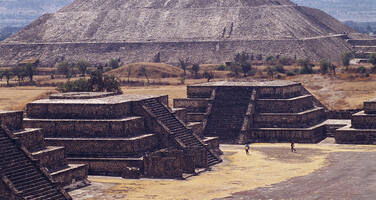Pre-Hispanic City of Teotihuacan
Factors affecting the property in 2008*
- Housing
- Management systems/ management plan
Factors* affecting the property identified in previous reports
a) Urban development pressures in areas surrounding the property;
b) Lack of management plan.
International Assistance: requests for the property until 2008
Total amount approved : 0 USD
Missions to the property until 2008**
2004: World Heritage Centre/ICOMOS reactive monitoring mission
Conservation issues presented to the World Heritage Committee in 2008
On 4 March 2008, the World Heritage Centre received the State Party’s report. The report was submitted in Spanish, but contains little new substantive information concerning the current situation to address the requests of the World Heritage Committee at its 31st session (Christchurch, 2007).
It outlines activities implemented since 2003 for the development of the management plan which has yet to be finalized because it is awaiting national approval. The long planning process considered a consultation approach, several working groups were formed to address current issues affecting the property by particular themes and/ or areas of expertise. Other interest and social groups were later integrated in the process to gather their assessments and proposals for the final compilation of the management document. However, no documentation was provided to assess the quality or comprehensiveness of the proposals made, how they will conserve the outstanding universal value of the property or how the major issues confronted, such as visitation, will be addressed in the short and long term.
In addition, representatives from the National Institute of Anthropology and History have participated in other planning initiatives that might impact the property, such as the Regional Programme for Touristic development of the Teotihuacan corridor and the urban plans for both municipalities related to the property. This participation is important but should be structured in a way where decisions regarding the property and its setting are taken in accordance to the conservation of the outstanding universal value and the integrity of the property and no detrimental actions are implemented. This programme is tourist oriented and it does not correspond to the decision of the World Heritage Committee that requested the State Party to set up an intersectoral working group at local, federal and national levels to analyze the archaeological, environmental and social impacts related to uncontrolled urban development.
An additional project has started to develop a geographic information system which will be useful for future decision making. However, in spite of all these actions there is still no articulation between the different levels of planning (territorial, municipal and site) and different proposals have not been brought together to guarantee there is no impact on the values of the property, including its setting. Although plans might exist, their implementation will pose a different challenge, particular in regard to illegal constructions or unplanned for developments in the areas.
Summary of the interventions
Decisions adopted by the Committee in 2008
32 COM 7B.123
Pre-Hispanic City of Teotihuacan (Mexico) (C 414)
The World Heritage Committee,
1. Having examined Document WHC-08/32.COM/7B;
2. Recalling Decision 31 COM 7B.127, adopted at its 31st session (Christchurch, 2007);
3. Reiterates its request to submit to the World Heritage Centre three printed and electronic copies of the finalized management plan by 30 October 2008, for review by the World Heritage Centre and the Advisory Bodies;
4. Invites the State Party to integrate the outcomes from other planning initiatives, such as the Regional Programme for Tourist Development and Municipal plans, into the management plan for the archaeological site, and to ensure the GIS system is available so that all appropriate actors can share the same information and tools for comprehensive decision-making;
5. Also reiterates its request to set up an intersectoral working group specifically for the World Heritage property, with representatives from local, federal and national levels to analyze the archaeological, environmental and social impacts related to uncontrolled urban development to collaborate in the management of the archaeological site and its surroundings;
6. Requests the State Party to submit to the World Heritage Centre, by 1 February 2009, a progress report on the agreements achieved as well as on the advance of preparation of the management plan, for examination by the World Heritage Committee at its 33rd session in 2009.
Draft Decision: 32 COM 7B.123
The World Heritage Committee,
1. Having examined Document WHC-08/32.COM/7B;
2. Recalling Decision 31 COM 7B.127, adopted at its 31st session (Christchurch, 2007);
3. Reiterates its request to submit to the World Heritage Centre three printed and electronic copies of the finalized management plan by 30 October 2008, for review by the World Heritage Centre and the Advisory Bodies;
4. Invites the State Party to integrate the outcomes from other planning initiatives, such as the Regional Programme for Tourist Development and Municipal plans, into the management plan for the archaeological site, and to ensure the GIS system is available so that all appropriate actors can share the same information and tools for comprehensive decision-making;
5. Also reiterates the request to set up an intersectoral working group specifically for the World Heritage property, with representatives from local, federal and national levels to analyze the archaeological, environmental and social impacts related to uncontrolled urban development to collaborate in the management of the archaeological site and its surroundings;
6. Requests the State Party to submit to the World Heritage Centre, by 1 February 2009, a progress report on the agreements achieved as well as on the advance of preparation of the management plan, for examination by the World Heritage Committee at its 33rd session in 2009.
Exports
* :
The threats indicated are listed in alphabetical order; their order does not constitute a classification according to the importance of their impact on the property.
Furthermore, they are presented irrespective of the type of threat faced by the property, i.e. with specific and proven imminent danger (“ascertained danger”) or with threats which could have deleterious effects on the property’s Outstanding Universal Value (“potential danger”).
** : All mission reports are not always available electronically.


